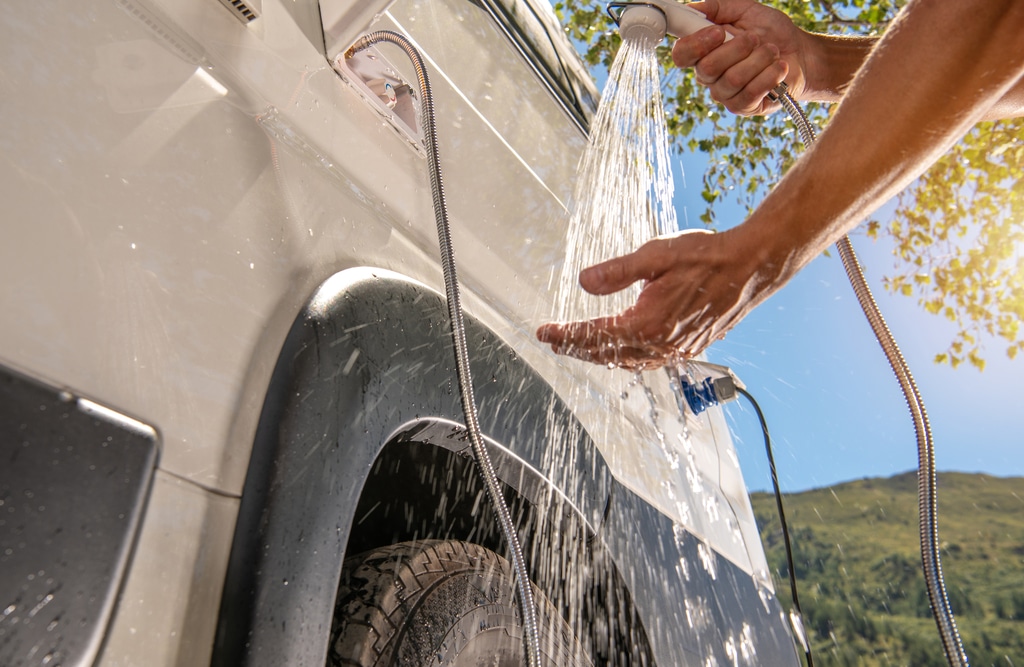One of the best things about an RV is taking it off the grid: boondocking, here we come! RV life is great when you can change locations whenever you want. When you take off for the backwoods, water is your most problematic resource.
Keeping this in mind can help you remember to fill up your RV tank when you have the chance, and find options for reducing your water use.
Before you head out
Knowing as much as you can about your RV tanks is the place to start. Capacities for freshwater tanks vary by the size and age of your RV. Then spend a few days tracking your normal water use per day and per week. With this information you can estimate how long you can stay in a dry camp before resupplying. This will help you plan for either a desert or mountain boondock.
Water conservation measures
Most RV freshwater tanks hold 40 to 50 gallons and the average American uses 20 gallons per shower. Toilet flushing, dish washing, cooking—all require water. However, there are several easy changes you can make to stretch your water.
In the bathroom
Most RVers know about the military shower method: Rinse, soap up with the water off, turn it on just to rinse. This can be done for shampooing. Out in the boonies, you may want to reduce the number of times that you shower and substitute a sponge bath. Hand sanitizer also reduces water use. Once you develop the turn-off-the-water habit, it becomes second nature—and helps the environment.
Keep your water heater full by turning on the water pump when filling the freshwater tank, but not the hot water heater. Turn a faucet on “hot” and listen for the sound of the tank filling. Then add more water to your freshwater tank.
Upgrade your toilet to a dual-flush or low-flush type. Better yet, get a composting toilet for serious water reduction. You can also upgrade to a low-flow showerhead and, regardless of the type, check it regularly for clogging.
In the kitchen
In the kitchen, steam instead of boiling vegetables and using a microwave can reduce water use. More one-pot dinners help, also. Any water from cooking or dishwashing goes into the gray water tank or can be used to flush the toilet. An additional option is to flush only when necessary. Some people collect shower water and use it for flushing.
If you want cold water, keep it in the fridge or even get reusable ice cubes, which are basically gel filled cubes.
Upgrade your toilet to a dual-flush or low-flush type. Better yet, get a composting toilet for serious water reduction. You can also upgrade to a low-flow showerhead and regardless of the type, check it regularly for clogging.
Add some new gadgets
Keep a small barbecue grill and cast iron pan for campfire cooking. The more you do outside, the better. However, experts strongly suggest not drinking from streams and rivers without purification to avoid ending up with parasites such as giardia. We also suggest you be familiar with methods of purification if you have an emergency, and keep the related supplies on hand.
Add a solar shower! And a portable latrine for avoiding additions to the black tank in the first place. Biodegradable soap and toilet paper are easy upgrades. Invest in a Scrubba Wash bag, an eco-friendly, award-winning system for washing clothes on the go.
Keep extra water in five-gallon containers. You can even purchase collapsible containers that you fill at reliable water sources as you travel. Many RVers keep a close watch on their tank levels and fill or dump at every opportunity.
Once you’ve exhausted your boondocking adventure, catch up with the outside world at Riverbound Custom Storage and RV Park and go for a splash in the pool. Fill those tanks. Play on the sports courts (pickleball anyone?) and do the laundry. Kick back for a while and explore the waterways of Lake Havasu City, AZ, without thinking about that freshwater tank!


